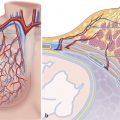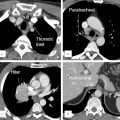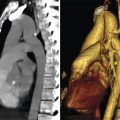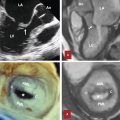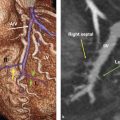6 Pulmonary Artery and Vein
Pulmonary Artery
The pulmonary trunk (the main pulmonary artery) originates at the base of the right ventricle, and the origin is located anterior to the aortic sinus. It moves posteriorly on the left side of the ascending aorta in the pericardial sac, and divides into the right and left pulmonary arteries in front of the left main bronchus at the level of T5 to T6 vertebra (Fig. 6‑1). The diameters of the pulmonary trunk, the right pulmonary artery, and the left pulmonary artery are approximately 24, 16, and 18 mm, respectively. Their upper limits are about 30, 20, and 22 mm, respectively. 1 The left pulmonary artery is slightly larger than the right pulmonary artery. The mean pressure of the pulmonary artery is 9 to 18 mm Hg in normal conditions, and it is elevated greater than 25 mm Hg in pulmonary hypertension. The wedge pressure, representing left atrial pressure, is 6 to 12 mm Hg, which is elevated in several pathological conditions such as left heart failure and mitral valve stenosis. The right pulmonary artery runs transversely behind the ascending aorta and superior vena cava to reach the root of the right lung (Fig. 6‑1 , Fig. 6‑2 , Fig. 6‑3). The right pulmonary artery divides into a superior and an inferior trunk (interlobar artery) behind the superior vena cava in the mediastinum (Fig. 6‑2 , Fig. 6‑3). The superior trunk generally gives off segmental arteries supplying the upper lobe. The inferior trunk (interlobar artery) runs laterally and inferiorly between the superior pulmonary vein and the right main bronchus, which gives off segmental arteries to the middle lobe and the inferior lobe. The segmental pulmonary arterial branches run along the accompanying branches of the bronchial tree. The left pulmonary artery ascends posteriorly, and arches over the left main bronchus laterally to the root of the left lung (Fig. 6‑1 , Fig. 6‑2). It gives off several superior lobar arteries (the number varies from two to seven branches) to supply the superior lobe, then it becomes interlobar artery which branches off into the segmental arteries to feed the left lower lung lobe. In both lungs, segmental and subsegmental branches are usually located in the vicinity of corresponding bronchi, however, branching patterns of the segmental/ subsegmental arteries are variable especially in upper lobes (Fig. 6‑2). The segmental and subsegmental arteries of both the pulmonary arteries are summarized in Table 6‑1.




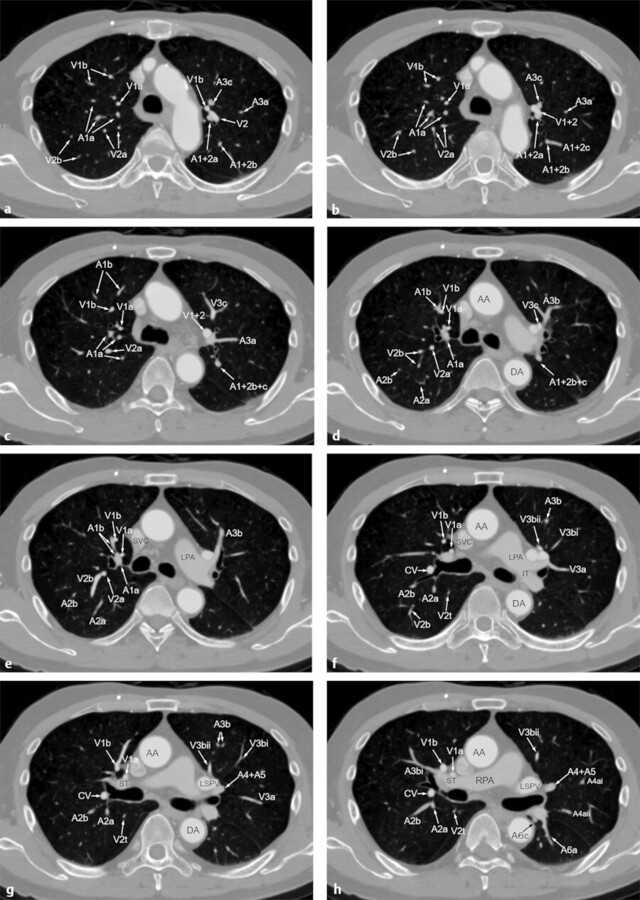


Right pulmonary artery | Left pulmonary artery | ||
Segmental artery | Subsegmental artery | Segmental artery | Subsegmental artery |
Upper lobe | Upper lobe | ||
A1, apical | A1a, apical | A1+2, apicoposterior | A1+2a, apical |
A1b, anterior | A1+2b, posterior | ||
A2, posterior | A2a, posterior | A1+2c, lateral | |
A2b, lateral | A3, anterior | A3a, lateral | |
A3, anterior | A3a, lateral | A3b, anterior | |
A3b, anterior | A3c, superior | ||
Middle lobe | A4a, lateral | ||
A4, lateral | A4a, superior | A4, superior lingula | A4b, medial |
A4b, lateral | A5, inferior lingula | A5a, superior | |
A5, medial | A5a, superior | A5b, inferior | |
A5b, inferior | Lower lobe | ||
Lower lobe | A6a, superior | ||
A6, apical | A6a, superior | A6, apical | A6b, lateral |
A6b, lateral | A6c, medial | ||
A6c, medial | A7, medial | ||
A7, medial | A7a, posterior | A8, anterior | A8a, lateral |
A7b, anterior | A8b, basal | ||
A8, anterior | A8a, lateral | A9, lateral | A9a, lateral |
A8b, basal | A9b, basal | ||
A9, lateral | A9a, lateral | A10, posterior | A10a, posterior |
A9b, basal | A10b, lateral | ||
A10, posterior | A10a, posterior | A10c, basal | |
A10b, lateral | |||
A10c, basal | |||
For the right upper lobe, the apical (A1: A1a, apical; and A1b, anterior) segmental/subsegmental artery arises from the superior trunk. The anterior subsegmental artery (A3b) of the anterior segmental artery (A3) usually arises from the superior trunk. The posterior (A2: A2a, posterior; and A2b, lateral) segmental/subsegmental arteries and lateral subsegmental artery (A3a) of A3 can originate from either the superior trunk or the interlobar artery (so-called ascending pulmonary artery). 2 , 3 The segmental arteries of the right middle lobe (A4, lateral; A5, medial) arise from the anterior aspect of the interlobar artery independently or from a common trunk. These segmental arteries further divide into subsegmental arteries (A4a, lateral; A4b, medial; A5a, superior; and A5b, inferior). The middle lobe segmental arteries occasionally originate from the artery to the basal segments (Fig. 6‑2). 4 , 5 The middle lobe arteries rarely give off a branch to the lower lobe. The lower lobe apical segmental artery (A6) originates from the posterolateral aspect of the interlobar artery opposite to the middle lobe artery. It runs posteriorly, accompanying the corresponding bronchus (B6), and divides into three subsegmental arteries (A6a, superior; A6b, lateral; and A6c, medial). One of these subsegmental arteries can rarely originate independently from the interlobar artery. After branching the A6, the left pulmonary artery divides into basal segmental arteries (A7, medial; A8, anterior; A9, lateral; and A10, posterior). They originate from the inferior pulmonary trunk either independently or via an anterior (A7 and A8) or a posterior trunk (A9 and A10). Each basal segmental artery subdivides into the following subsegmental arteries: A7a, dorsal; A7b, ventral; A8a, lateral; A8b, basal; A9a, lateral; A9b, basal; A10a, posterior; A10b, lateral; and A10c, basal. The basal segmental arteries are occasionally duplicated or even triplicated surrounding a corresponding bronchus. 6
For the left upper lobe, the anterior segmental artery (A3) arises from the anterosuperior aspect of the left pulmonary artery at the arch, and then the apicoposterior segmental (A1+2) or the subsegmental arteries (A1+2a, apical; A1+2b, posterior; and A1+2c, lateral) arise independently or with a common trunk from the posterosuperior aspect of the left pulmonary artery. The anterior segmental artery (A3) further subdivides into three subsegmental arteries (A3a, lateral; A3b medial; and A3c, superior). The left pulmonary artery enters the major fissure, becoming interlobar artery, and runs on the side of the lower lobe bronchus. The lingular segmental arteries (A4, superior; and A5, inferior) arise from the anterior aspect of the interlobar artery independently or as a single trunk. The lingular arteries rarely originate from the other upper lobe arteries or the basal segmental arteries. Branching pattern and course of the segmental arteries to the left lower lobe are similar to the right pulmonary artery. The apical segmental artery of the left lower lobe (A6) usually originates at slightly higher portion of the interlobar artery compared to its fellow on the right side. Medial basal segmental artery (A7) is often subtle or unidentified on the left side.
Intrapulmonary arteries divide and subdivide along the bronchi and bronchioles which lie in the central portion of the secondary and then the primary pulmonary lobules. There, they become arterioles proceeding along the respiratory bronchioles and alveolar ducts to form capillary networks in the alveolar walls for gas exchange. 7 These capillary networks continue to the pulmonary venules which join the pulmonary veins which are located in the interlobular septa.
Pulmonary Vein
The pulmonary vein in the interlobular septa join together to form segmental pulmonary veins. Unlike the segmental pulmonary arteries, the segmental pulmonary veins are not close to the bronchi, instead they run within the intersegmental septa. The segmental pulmonary veins join to form two common trunks of the superior pulmonary vein and the inferior pulmonary vein which connect to the left atrium on each side. The orifices of the inferior pulmonary veins are more dorsal than those of the superior pulmonary veins (Fig. 6‑2). 8 The orifices of the left pulmonary veins are located more superiorly than those of the right pulmonary veins (Fig. 6‑1). 9 , 10 There are some variations of the pulmonary veins. The left superior and inferior pulmonary veins occasionally form a single common trunk before entering the left atrium (Fig. 6‑4). Other variations are accessory pulmonary veins, including one or more accessory middle pulmonary veins and the upper pulmonary vein which directly connect to the left atrium (Fig. 6‑5 , Fig. 6‑6). Recognition of these variations of the pulmonary veins is important for thoracic surgery and catheter ablation treatment of arrhythmic cardiac diseases.
Subsegmental pulmonary veins and their relationship to the pulmonary (sub)segments are summarized on Table 6‑2.
The right superior pulmonary vein usually receives the segmental or lobar veins from the right upper lobe and the middle lobe, which are located anterior and inferior to the right pulmonary artery. The subsegmental veins of posterior segment (V2a, apical; V2b, posterolateral; and V2c, horizontal) join to form the central vein which is located at the central portion of the upper lobe and descend between the B2 (posterior) and B3 (anterior) segmental bronchi (central vein type), and then join to the superior pulmonary vein superiorly (Fig. 6‑2 , Fig. 6‑6). At the right lung apex, the apical (V1a) and the anterior (V1b) subsegmental veins of the apical segment join to form apical segmental vein (V1) which runs downward. These V1 subsegmental veins totally or partially join to form the central vein or descend anteromedial to the central vein (anterior vein) joining the superior pulmonary vein anterosuperiorly. Subsegmental veins of anterior segment (V3) can join the central vein, the anterior vein, or independently to the superior pulmonary vein. V3d (lateral) subsegmental vein generally joins the central vein. In some cases, the common trunk of V1 and V2 subsegmental veins runs anteriorly far above the bifurcation of the B2 and B3, which descend anteromedially to the upper bronchi (semicentral vein type) (Fig. 6‑7). This type of upper lobe venous drainage is more frequently seen in the left lobe. One or two subsegmental veins of the V2 (especially V2t, terminal) occasionally descend on the posterior surface of the bronchus intermedius, which drain either into the superior pulmonary vein or the inferior pulmonary vein. 11 In the right middle lobe, two segmental veins of V4 (lateral) and V5 (medial) are generally formed by the subsegmental veins. The V4a (posterior) and V4b (anterior) join to form the V4, and the V5a (superior) and V5b (inferior) form the V5, respectively. The segmental veins join together to form the middle lobe vein which usually joins the superior pulmonary vein. In some cases, the segmental veins or subsegmental veins independently join to the superior pulmonary vein. The middle lobe vein or the segmental vein occasionally drains directly into the left atrium or the inferior pulmonary vein (Fig. 6‑5 , Fig. 6‑6 , Fig. 6‑8). 12 Exceptionally, the lateral segmental vein (V4) or its subsegmental vein empties into the anterior segmental vein (V3) of the upper lobe. 13










The right inferior pulmonary vein is formed by all five segmental veins of the right lower lobe. It occasionally receives segmental or subsegmental veins from the middle lobe or the upper lobe (V2). Three basal segmental veins of the V8 (anterior), the V9 (lateral), and the V10 (posterior) ascend medially by crossing behind their respective bronchi to form the common basal vein. The V7 (medial) basal segmental vein is a small intersegmental vein which ascends posteriorly to join the common basal vein at the anteroinferior aspect. The V6 (lower lobe apical segmental vein) descends from the apex of the lower lobe, crosses behind the basal bronchus to join the common basal vein to form the inferior pulmonary vein. The V6 segmental vein rarely receives a V2 subsegmental vein and ends directly into the left atrium.
Branching pattern of the left pulmonary veins is similar to that of the right pulmonary veins. As mentioned before, semicentral type of venous drainage of the upper lobe vein is more frequent in the left lung. One or both lingular veins may, like the middle lobe veins, empty into the inferior pulmonary vein or directly into the left atrium. However, the direct drainage of lingular vein into the left atrium is much less frequently on the left side.
Stay updated, free articles. Join our Telegram channel

Full access? Get Clinical Tree


